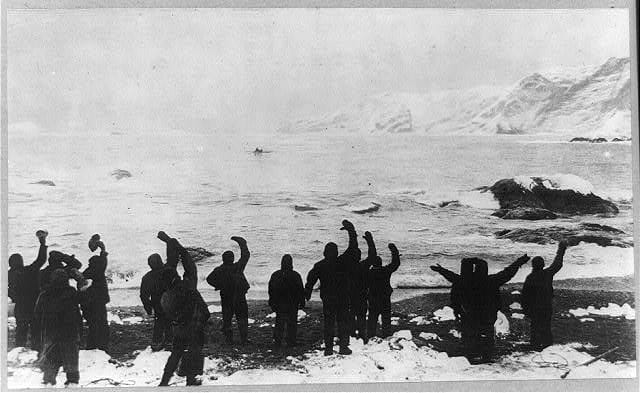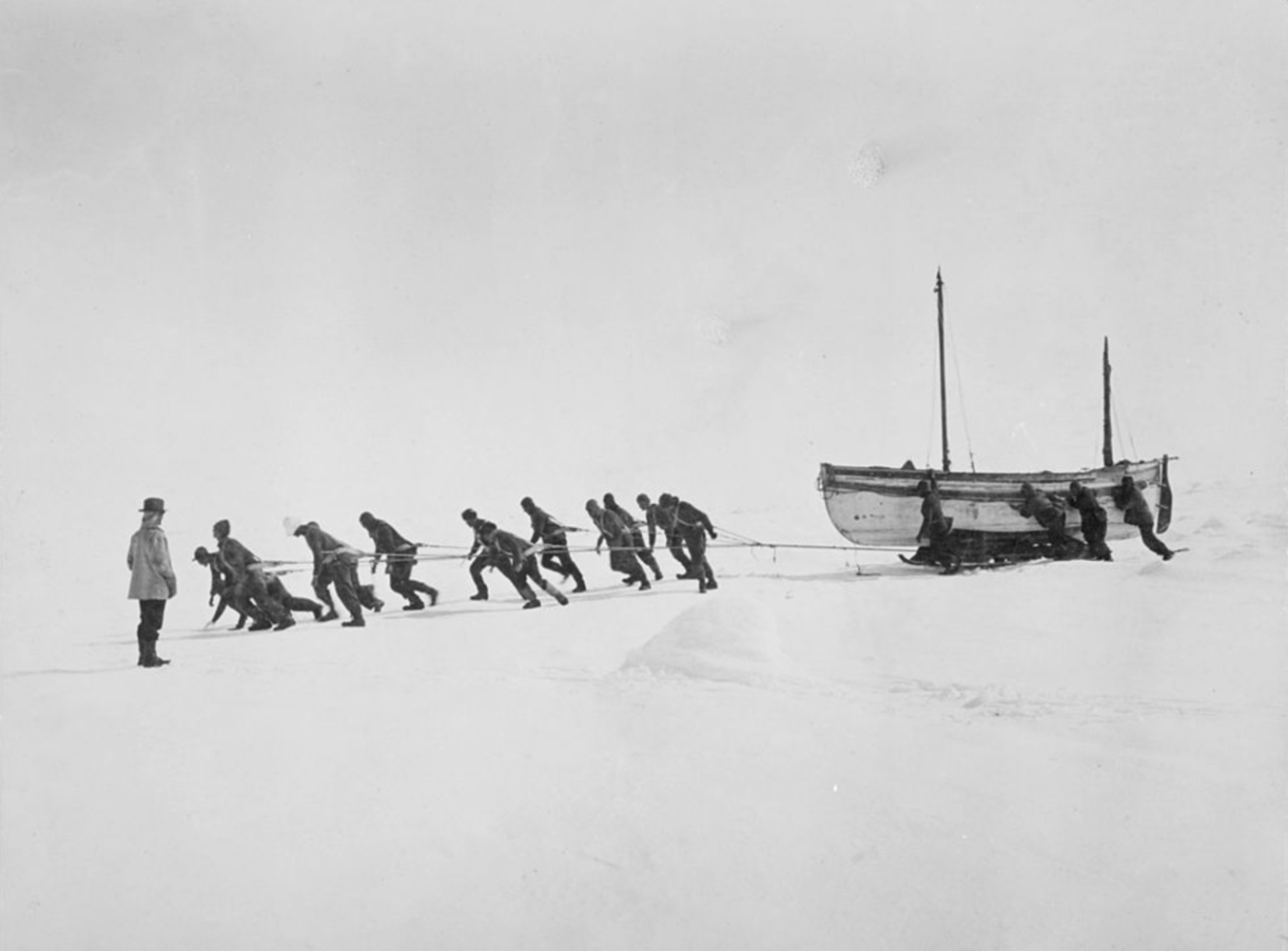Leadership Stories:

The Story of Ernest Shackleton and the Endurance Expedition
Reading leadership stories of great leaders has a huge return on your investment. In addition to being a part of your journey of life-long learning, leadership stories from history can inspire and serve as examples to emulate. President Harry Truman was known for his avid reading and knowledge of history. He said, "The only thing new in the world is the history you don't know."
One of the best historical books I have read is Endurance: Shackleton's Incredible Voyage by Alfred Lansing, written in 1959 but only published in 1986. It is a compelling novel because it is a true story of men who faced insurmountable odds of survival but with good leadership, grit, and determination they all returned home. There were numerous times where I had to put the book down and shake my head at the toughness of the men and the calm and focus of Shackleton.
Unlike the land, where courage and the simple will to endure can often see a man through, the struggle against the sea is an act of physical combat, and there is no escape. It is a battle against a tireless enemy in which man never actually wins; the most that he can hope for is not to be defeated.
pg 225
Background:
In 1914, Sir Ernest Shackleton led an expedition to cross Antarctica from sea to sea, known as the Imperial Trans-Antarctic Expedition. The mission faced significant challenges and ultimately became a legendary tale of survival and leadership.
The Challenge:
Shackleton and his crew of 27 men set sail on the ship "Endurance". However, the ship became trapped in the dense pack ice of the Weddell Sea. For months, the crew lived on the ice as their ship was slowly crushed by the pressure, eventually sinking. Sitting on a sheet of ice with nowhere to go, Shackleton and crew drug lifeboats across frozen ocean, sleeping on the noisy, cracking ice to get to the South Ocean in hopes of putting their lifeboats to sea and rowing 180 miles to Elephant Island with prayers of achieving safety and then rowing another 800 miles to the island of South Georgia for help. Just one degree of error in navigation could have resulted in the crew missing their target by over 13 miles and pushing them into the treacherous South Ocean, the only ocean to circumnavigate the globe unimpeded by land with swells reaching 200 feet high.

Leadership in Crisis:
Shackleton's leadership was tested to its limits. Recognizing the dire situation, he made the decision to abandon the goal of crossing Antarctica and focused entirely on the survival of his men.
Key Actions:
1) Maintaining Morale: Shackleton kept the crew's spirits high by organizing regular activities, routines, and keeping them occupied with tasks. He also maintained a positive attitude, never letting despair show in front of his men.
This indomitable self-confidence of Shackleton’s took the form of optimism. And it worked in two ways: it set men’s souls on fire; as Macklin said, just to be in his presence was an experience. It was what made Shackleton so great a leader.
But at the same time, the basic egotism that gave rise to his enormous self-reliance occasionally blinded him to realities. He tacitly expected those around him to reflect his own extreme optimism, and he could be almost petulant if they failed to do so. Such an attitude, he felt, cast doubt on him and his ability to lead them to safety.
2) Decision-Making and Leading by Example: When the Endurance was crushed and sank, Shackleton led the men on a grueling journey across the ice to reach open water. They used lifeboats to reach Elephant Island, an uninhabited and desolate place.
After Shackleton made the decision to abandon the ship, he knew those who fared worst were those who burdened themselves with too much gear and equipment. Leading by example, he gathered his men and gave them strict guidelines of carrying only two pounds of personal gear each. He then threw on the snow at their feet a gold cigarette case, several gold sovereigns and tore out the flyleaf and the Twenty-third Psalm of the Bible the Queen Mother Alexandra had given them and then laid it in the snow.
3) Personal Sacrifice and Adaptability: Shackleton made the difficult decision to leave most of his men on Elephant Island while he and a small team set out on a perilous 800-mile journey in a small lifeboat to seek help. This journey to South Georgia Island involved navigating treacherous seas and crossing a mountain range upon reaching the island.
This 800-mile journey to save his men was thought to likely lead to death. In 1914 navigation was done via celestial navigation, compass, an accurate chronometer, and maps. The precision required to reach South Georgia Island is nearly incomprehensible today and the consequence of error was certain death.
4) Resilience and Perseverance: Shackleton's determination was unwavering. After reaching South Georgia Island, he immediately organized a rescue mission. Despite four failed attempts due to severe weather and ice, he persisted for four months until he successfully returned to rescue his men.
Outcome:
Remarkably, Shackleton managed to bring every one of his men back alive after nearly two years in one of the most inhospitable environments on Earth. Not a single life was lost, a testament to his exceptional leadership.
Leadership Moral:
Shackleton’s story illustrates several critical leadership qualities:
- Resilience: Maintaining a positive outlook and relentless determination in the face of adversity.
Shackleton was quick to keep attitudes positive as he knew negative attitudes would destroy their chances of survival. - Empathy and Morale Building: Recognizing the importance of morale and mental well-being of the team.
Shackleton was keenly aware of group dynamics, separating those who did not mesh well with the majority of the sailors like the photographer and surgeon away from living with the men and in his own personal tent. - Adaptability: Being willing to change plans and strategies in response to changing circumstances.
I questioned whether to include this characteristic because the choices required of Shackleton and the crew seem so logical in the face of death. Stay on a sinking ship or get off? Stay on the ice or travel to rescue? However, if Shackleton had not made these decisions, at some point someone else would have. Shackleton's adaptability could be considered being forced to make the only decision possible, but where Shackleton was different was his steadfast discipline in changing strategy and not looking back.
Shackleton did not hold on to both options, he was decisive. As a metaphor, many leaders will make the mistake of attempting to hold on to two ropes pulling in different directions until it is too late and the decision is made for them. Or worse, it impacts team dynamics as the group fragments into those who support one side or the other. - Leading by Example: Showing personal courage and taking on the most challenging tasks alongside the team.
But it was inescapable. He was the Boss. There was always a barrier, an aloofness, which kept him apart. It was not a calculated thing; he was simply emotionally incapable of forgetting—even for an instant—his position and the responsibility it entailed. The others might rest, or find escape by the device of living for the moment. But for Shackleton there was little rest and no escape. The responsibility was entirely his, and a man could not be in his presence without feeling this. His aloofness, however, was mental—rarely physical. He was very much in evidence, taking part in all the men’s activities. pg 101
Shackleton's leadership during the Endurance expedition remains a powerful example of how strong, empathetic, and adaptable leadership can lead to extraordinary outcomes, even in the most challenging situations.
Conclusion
The story of Ernest Shackleton and the crew of the Endurance highlights the importance of steady leadership in crisis which emphasizes resilience, building morale, adaptability, and leading by example. Shackleton was not a saint. He had his imperfections, but despite those he gave his men confidence that he could lead them to safety. You too, don't have to be perfect to be a good leader. The story of the Endurance serves as an example of what is possible when you face your own leadership crisis.
If you enjoyed this post and want weekly updates to help you reach your leadership potential, enter your email and sign up for free.
Additional Recommendations
Some additional leadership books you may consider:
- Turn the Ship Around by David Marquet
- Leaders Eat Last by Simon Sinek
- Extreme Ownership by Jocko Willink and Leif Babin





Member discussion